|
Generating Artifacts
To generate artifacts by template, it must be applicable to current working UML model.
| 1. | Select [Tools]->[StarUML Generator...] Menu |
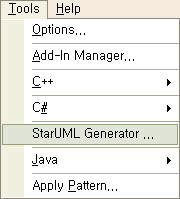
| 2. | In the [Select templates for generation] Page, Check templates to generate in the ListBox and Click [Next] Button. |
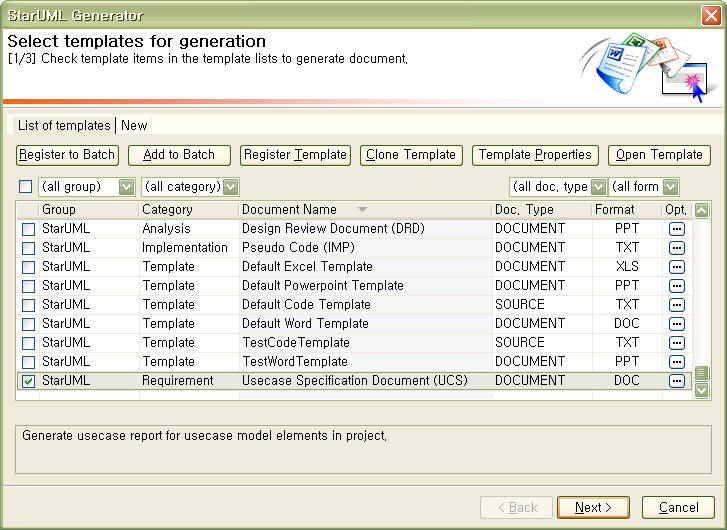
| 3. | To bind values with parameters, Click  Button of each template item in the ListBox, and set values of parameter as you want. (Refer to Registering Template for more information about template parameters) Button of each template item in the ListBox, and set values of parameter as you want. (Refer to Registering Template for more information about template parameters) |
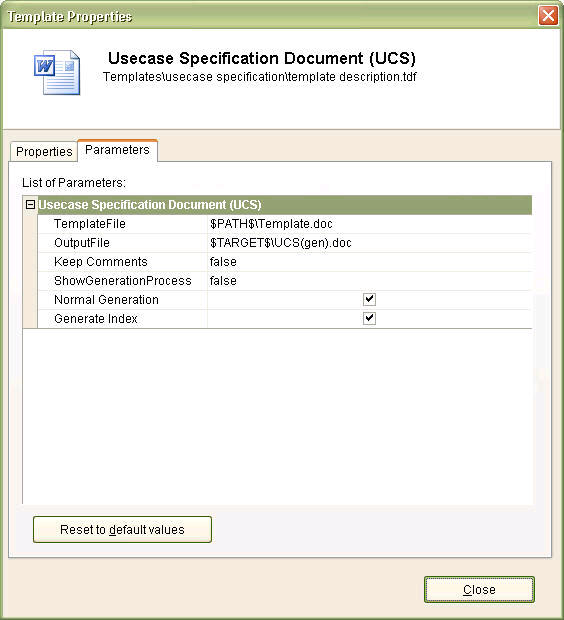
| 4. | In the [Select target path] Page, Select a folder that generated artifacts will be placed and click [Next] button. |
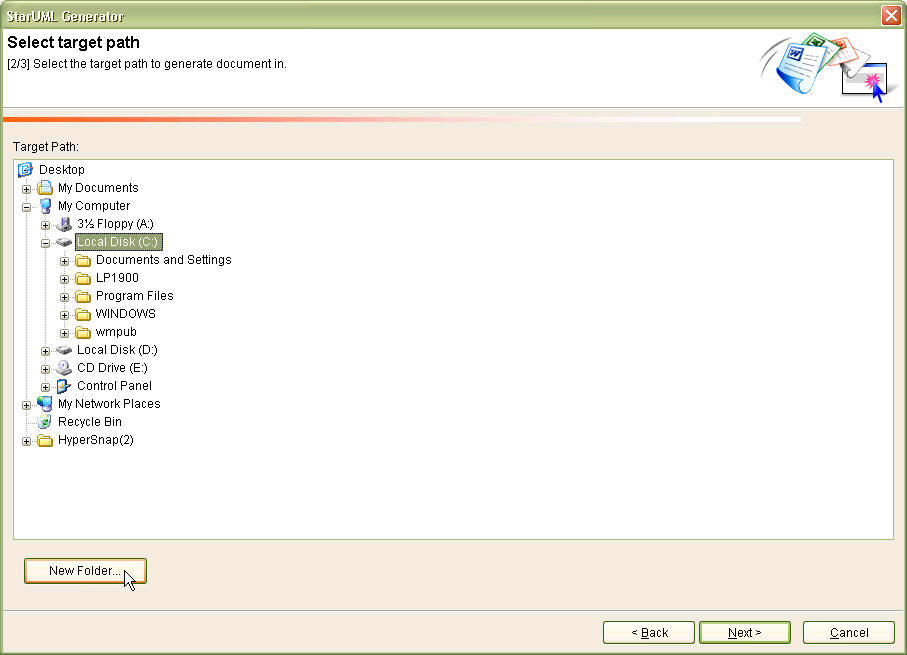
If you want to create a new folder, click [New Folder...] button and input name of the new folder.
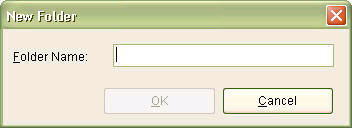
| 5. | In the [Generating...] Page, click [Generate] button. You can check the progress of generation and it will be logged on Logs. If you want to cancel the generation process, click [Cancel] button. When all artifacts are successfully generated, [Finish] will be enabled and clicking it will finish the artifact generation. To see generated artifacts, double-click the item that want to see in the [Generation List] then the generated artifact will be opened. |
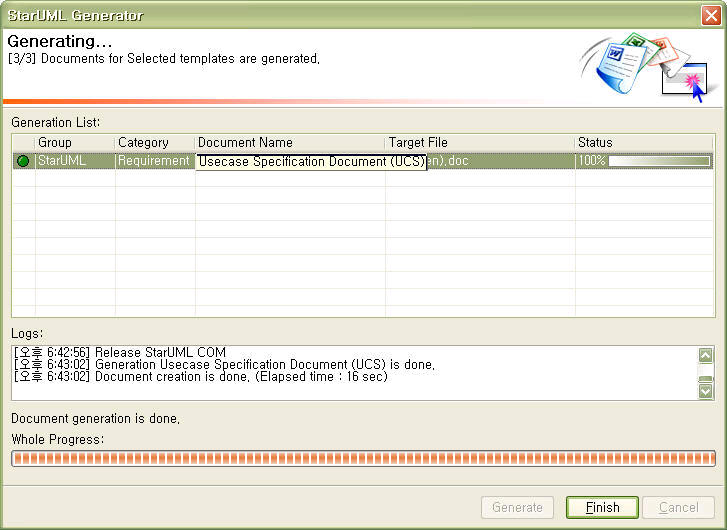
Registering a Template
Your own templates can be registered in StarUML Generator.
| 1. | In the [Select templates for generation] Page, click [Register Template] button. |
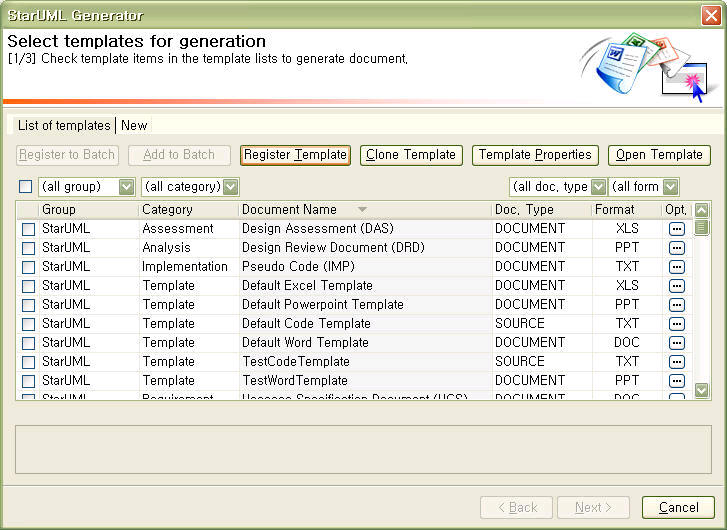
| 2. | In the [Register Template] Dialog, click  button and select a folder that the template files will be placed. button and select a folder that the template files will be placed. |
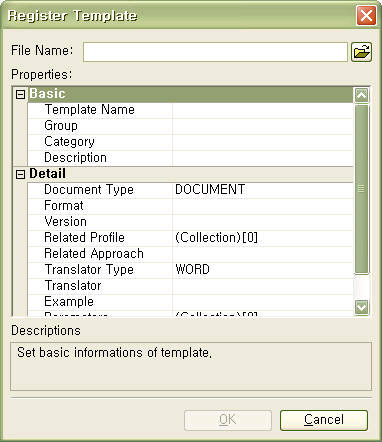
| 3. | Input template information on [Properties:] and click [OK] button to complete registering a template. |
[Basic] property section
Basic properties for template registration.
Property
|
Description
|
Template Name
|
Name for the template to register.
|
Group
|
Group name for the template. There is no restriction to name a group but to group a set of template, give the same group name for the set of templates. (it is used for horizontal classification like as RUP, CBD, <ModuleName>, <CompanyName>, ...)
|
Category
|
Category name for the template. There is no restriction to name a category but to categorize a set of template, give the same category name for the set of templates. (it is used for vertical classification like as Requirements, Design, Code, Analysis, ...)
|
Description
|
Brief description of the template.
|
[Detail] property section
Detailed properties for template registration.
Property
|
Description
|
Document Type
|
Type of the template. Select DOCUMENT or CODE.
|
Format
|
Type of generated artifact. Input the format name or select one of the already defined formats (TXT, DOC, PPT, XLS)
|
Version
|
Version of the template
(e.g) 1.0
|
Related Profile
|
Profiles related to the template.
|
Related Approach
|
Approach related to the template. (it is a declarative property, so it will not effect anything)
|
Translator Type
|
Kind of translator for the template. Select one of the following: WORD, EXCEL, POWERPOINT, TEXT, COM(user-defined COM-based generator), SCRIPT(user-defined scripts like as JScript, VBScript, ...), EXE(user-defined .EXE-based generator).
|
Translator
|
Specify filename of user-defined translator. It is used only for user want to use his/her own translator not built-in translators(WORD, EXCEL, POWERPOINT, TEXT)
|
Example
|
If any, specify an example model for the template.
|
Parameters
|
Parameters required for the template.
|
Related files
|
If any, specify all related files to the template.
|
[Parameters] property
| 1. | Click  button in Parameters property. button in Parameters property. |

| 2. | In the [Parameters] Dialog, click  button to create a new parameter and click button to create a new parameter and click  button to delete a existing parameter. button to delete a existing parameter. |
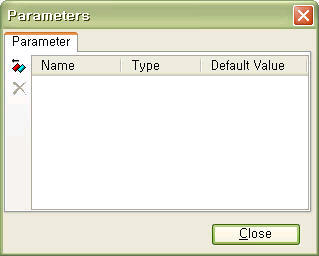
| 3. | In the [New Parameter] Dialog, specify Name, Type and Default Value for the parameter and click [OK] button. |
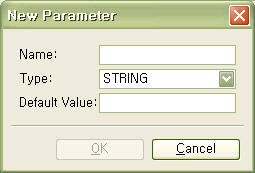
Default parameters are different according to the Translator Type. Following are the default parameters for each Translator Types.
Property
|
Type
|
Translator Type
|
Description
|
TemplateFile
|
FILENAME or STRING
|
WORD,EXCEL,
POWERPOINT
|
Specify file name of the template document.
|
OutputFile
|
FILENAME or STRING
|
WORD,EXCEL,
POWERPOINT,
TEXT
|
Specify file name of the generated artifact.
|
Keep Comment
|
BOOLEAN
|
WORD,EXCEL,
POWERPOINT
|
Specify whether to remain the comment used for generation or to delete it.
|
ShowGenerationProcess
|
BOOLEAN
|
WORD,EXCEL,
POWERPOINT
|
Specify whether to show the progress of generation or not. It may affect the performance of the generation.
|
Normal Generation
|
BOOLEAN
|
WORD
|
If true, the template is applied to top-level package (Project). if false, the template is applied to the package (or element) that is currently selected in StarUML.
|
Generate Index
|
BOOLEAN
|
WORD
|
Specify whether to generate Index or not.
|
intermediate
|
STRING
|
TEXT
|
Specify file name of intermediate file used for generation.
|
target
|
STRING
|
TEXT
|
If more than two artifacts are generated, specify the pathname the artifacts are placed.
|
Note:
To specify file name in the parameters, environment variables is required of StarUML Generator. The variable is as follow.
Variable
|
Description
|
$PATH$
|
The path that the template files are placed.
(e.g.) $PATH$\BusinessActorReport.doc
|
$GROUP$
|
Group name of the template.
|
$CATEGORY$
|
Category name of the template.
|
$NAME$
|
Name of the template.
|
$TARGET$
|
Output path that the user selected.
|
Cloning a Template
You can start to define a template by cloning an existing template without defining from the scratch.
| 1. | In the [Select templates for generation] Dialog, select a template to clone and click [Clone Template] button, or click mouse right button on the template to clone and then click [Clone Template] menu on the popup menu. |
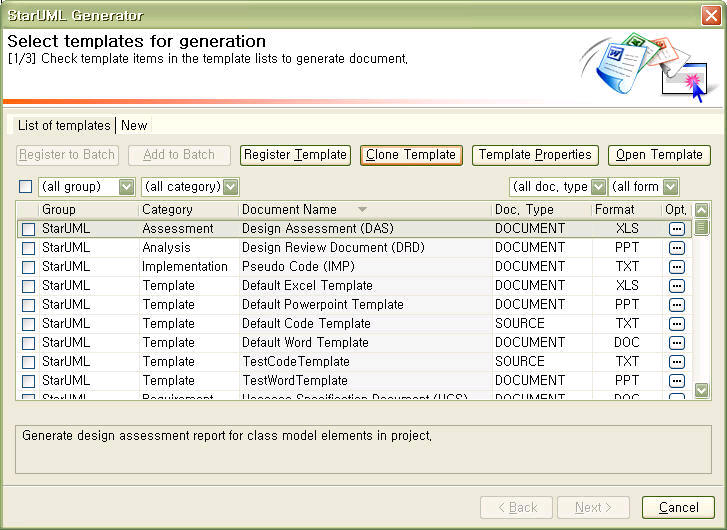
| 2. | Specify the name of cloned template and click [OK] button. |
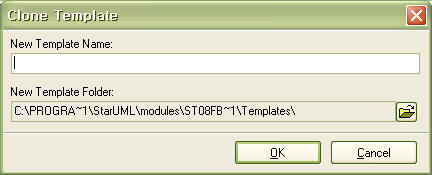
| 3. | You can find the cloned template in the [List of templates]. You can edit more information of the cloned template (click [Template Properties] button). |
Template Properties
You can edit properties of a registered template.
| 1. | In the [Select templates for generation] Dialog, select a template want to edit properties and click [Template properties] button, or click mouse right button on the template to edit properties and then click [Show Template Properties] menu on the popup menu. |
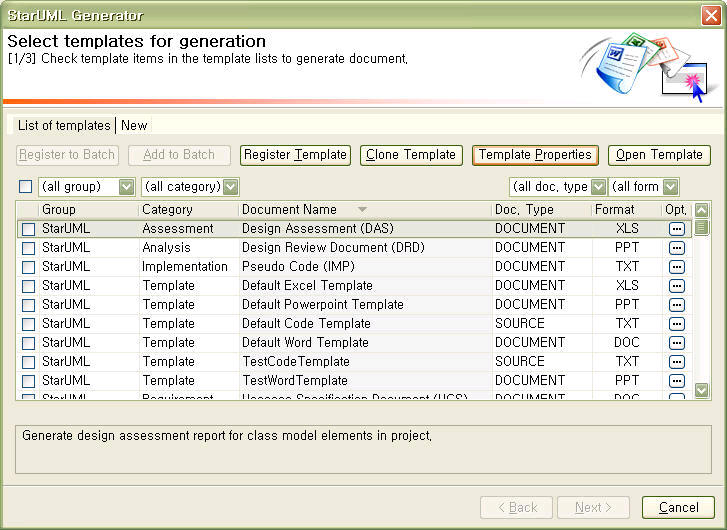
| 2. | Edit properties in the[Modify Template] Dialog and click [OK] button. (Please refer to Registering Template > Basic/Detail Parameters for detailed information of each property) |

Opening a Template
You can open and edit a registered template.
| 1. | In the [Select templates for generation] Dialog, select a template to open and click [Open Template] button, or click mouse right button on the template to open and then click [Open Template] menu on the popup menu. |

| 2. | And then, the default application associated with each file extension (.cot, .doc, .xls, .ppt) will be executed and you can edit in the application. (Please refer to StarUML 5.0 Developer Guides > Chapter 11. Writing Template for how to write template) |
Deleing a Template
| · | In the [Select templates for generation] Dialog, select a template to delete and click mouse right button and click [Delete Template] menu in the popup menu. |

| · | Deleting a template causes deletion of the template folder and all files in the folder, so you must take care about deleting template. |
|





















